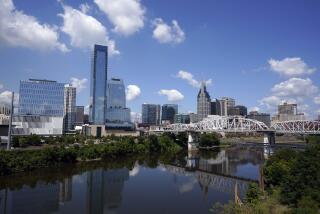Do we even want assistance?
Today, Leonard and Thornberg discuss the public’s reluctance to support government assistance for troubled borrowers. Later in the week, they’ll debate pay-day lending regulations, the Bear Stearns deal and more.
The ripple effects of absent regulation
By Paul Leonard
The heart of the mortgage market’s problems were and remain sub-prime loans. In California, data from the Mortgage Bankers Assn. show that while sub-prime loans make up 14% of total mortgages, they are responsible for about 60% of all foreclosures. Sub-prime loans -- many of which had stated-income requirements without verification, low teaser rates, no down payments and aggressive marketing tactics by brokers who had strong financial incentives to close loans -- increase chances of foreclosure. Reckless lending with little regulatory oversight helped get us into this mess.
Foreclosure spillover has much broader consequences -- for neighbors, local government services and our state and national economies. The Center for Responsible Lending recently estimated that 356,000 foreclosures will occur in California in 2008-09. With each foreclosure reducing surrounding home values by nearly 1%, we estimate that 7.5 million owners who live near foreclosed properties will lose a total of $107 billion of wealth in their homes. Possible municipal bankruptcies and deep local government program cuts, combined with historic levels of state budget deficits and the looming national recession, are all byproducts of the highest foreclosure levels since the Great Depression.
The Center for Responsible Lending has been urging lenders to perform loan modifications for owner-occupied homes with sub-prime mortgages, which would avoid costly foreclosures and allow people to remain in their homes. Even after bold announcements by U.S. Treasury Secretary M. Henry Paulson Jr. and California Gov. Arnold Schwarzenegger that they will commit to expanding streamlined loan modifications, the results have been disappointing. Foreclosures in California grew by 50% from December to January; loan modifications declined by 30% from November to January.
We do not want to bail out the lenders and investors who have made these bad loans. JPMorgan Chase & Co. received $30 billion in Federal Reserve guarantees in its emergency purchase of Bear Stearns. That smacks of socializing risks while keeping the profits private. And through federal interest-rate cuts, banks and millions of borrowers in adjustable rate loans have received some relief.
Given industry apathy toward voluntary loan modifications, the only way to achieve meaningful relief on a larger scale is to tweak bankruptcy laws. Courts should be allowed to restructure mortgages on family’s homes. Most loan modifications would occur voluntarily outside of court with no cost to taxpayers. Bills in the House (H.R. 3609) and the Senate (Sen. Richard Durbin’s bill, S 2636, included as Title IV of the Foreclosure Prevention Act) would give judges the authority to modify harmful sub-prime mortgages to provide families with one last chance to save their homes. These bills would help some 600,000 families avoid foreclosure.
Paul Leonard is the director of the California office of the Center for Responsible Lending.
It’s unfair prices, not unfair loans
By Chris Thornberg
The mortgage loan modification plans put forward by the governor and, at various times and in various forms, by the U.S. Treasury Department all failed to fix the problems in the housing markets. Why? They pretended that the problem is the structures of the mortgages used to buy houses -- in other words, fix the interest rate and you fix the problem. Make the loan “fair” and everything will be fine.
Nothing could be further from the truth. The real issue in today’s housing markets is that prices currently sit at levels that are unaffordable given income levels in our state. Take Los Angeles County, where the median price of a house peaked higher than $530,000. With a 6% interest rate and assuming a 10% down payment, the total annual cost of owning such a house would be $35,000 for the mortgage alone and $43,000 if taxes and insurance are thrown in. This would eat up roughly 75% of gross annual income of your median homeowner in the county -- much more than twice the maximum affordability rate used by Fannie Mae and Freddie Mac when making loan decisions. Prices are going to fall one way or another; it’s only a function of time. They simply aren’t sustainable at their current levels.
So what caused prices to go so high? Home bubbles are nothing new. We had one in the late 1980s, another in the late ‘70s and certainly many others before then. The bubbles are characterized by people buying an asset, in this case a home, and thinking they can sell it at a higher price regardless of the fact that the price being paid is completely out of whack relative to fundamentals such as income. At their root, all bubbles are driven by individual greed -- the desire to make money.
Think of it this way: Every buyer over the last few years had a choice: Buy a home or rent an apartment until income was more in line with prices. Many leaped into the housing market even as prices climbed to such high levels because they thought they could sell at a higher price. To a degree, they were all speculators. This bubble is larger than any we have seen since at least World War II because the sub-prime markets gave buyers the means to speculate like never before. As a result, prices went up like never before. This isn’t a sub-prime problem; it’s the same old greed problem on sub-prime steroids.
No one likes to think of a family thrown out of a house. But many people made a very unwise decision in recent years: They bought a house they couldn’t possibly afford. Needless to say, they had help from the real estate agent who told them that prices couldn’t fall, the mortgage broker who promised them they could refinance easily in a year or two to cover the higher payments, and, of course, from a financial community that bought sub-prime-backed securities despite all the evidence of everything that was going wrong. Now that the house of cards is falling, all parties are taking a hit. But it all started with buyers who bought something they couldn’t afford and listened to the words they wanted to hear to help themselves justify that bad decision. You can’t have a lender without a borrower. To single out that one party as the hapless victim is to distort the true situation. Everyone had a choice -- and still has one. If you can’t afford to buy, you rent.
People make mistakes. We give them a second chance by allowing them to bankrupt themselves out of debt they couldn’t afford even if they arrived in this situation because they made an error. We pay for this right through high interest-rate premiums on consumer loans. Years ago, in an effort to make buying homes cheaper, the home asset was opted out of the bankruptcy system. Because the home is a secured asset that could be repossessed in the event of a lack of payment, we all have enjoyed lower interest rates. But the game is simple -- if you can’t make the payment, you lose the house. To change the game now is to violate this simple rule; that violation will lead to high costs of capital in the long run for anyone playing in the housing market. In other words, changing bankruptcy laws as they relate to mortgages would punish those who made the prudent decision to stay on the sidelines and not buy something they couldn’t afford.
Christopher Thornberg is a founding partner with Beacon Economics.
Day 1 | | |
More to Read
A cure for the common opinion
Get thought-provoking perspectives with our weekly newsletter.
You may occasionally receive promotional content from the Los Angeles Times.






